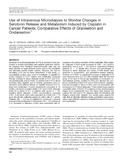Use of intravenous microdialysis to monitor changes in serotonin release and metabolism induced by cisplatin in cancer patients: Comparative effects of granisetron and ondansetron
Fecha
1999Metadatos
Mostrar el registro completo del ítemResumen
Serotonin [5-hydroxytryptamine (5-HT)] is involved in the production
of emesis associated with cisplatin treatment. Serotonin
released from intestinal enterochromaffin cells may act
either directly on vagal afferents and/or pass to the circulation
and stimulate central emetic centers. However, the role for
circulating 5-HT has not been determined. In this study, i.v.
microdialysis probes were used to investigate 1) cisplatin-induced
changes in 5-HT release and metabolism assessed
through changes in blood dialysate levels of 5-HT and 5-hydroxyindoleacetic
acid (5-HIAA), 2) whether free 5-HT in blood
increases after cisplatin, and 3) whether granisetron and ondansetron
exert different effects on cisplatin-induced 5-HT release
and metabolism. Control experiments conducted in 10
healthy volunteers revealed stable 5-HT and 5-HIAA dialysate
levels for a period of 6 h. In patients with cancer (n 5 16),
baseline blood dialysate 5-HIAA concentrations averaged
2.98 6 0.38 ng/ml, which were equivalent to a total of 94 6 10
pg in the 30-min collection period at a flow rate of 1 ml/min.
Cisplatin (89 6 2.9 mg of cisplatin/m2) produced a gradual
increase in blood dialysate 5-HIAA levels (104 6 4% increase at
4 h). Increases in dialysate 5-HIAA were associated with increases
in the urinary excretion of this metabolite. After cisplatin,
dialysate 5-HIAA levels increased to 5.89 6 0.5 ng/ml in
granisetron and to 5.27 6 0.9 ng/ml in ondansetron-treated
patients (P . .1). Similar time courses and percentages of
increase in blood dialysate and urinary 5-HIAA levels were
observed in ondansetron- and granisetron-treated patients.
Contrary to 5-HIAA, no significant increases in dialysate 5-HT
were observed from 2 to 8 h after cisplatin either for the total
group or for each of the groups separately. In conclusion, i.v.
microdialysis probes coupled to HPLC-EC allowed the continuos
monitoring of free-5-HT and 5-HIAA in blood. Cisplatininduced
increases in blood 5-HIAA were not associated with
increases in 5-HT blood dialysates. These results argue against
a possible action of free 5-HT in plasma on the chemoreceptor
trigger zone (unprotected from the blood brain barrier) but
support the view that 5-HT released within the intestinal wall
triggers emesis after cisplatin. Our results argue against the
view that at clinically effective doses, granisetron and ondansetron exert different actions on cisplatin-induced 5-HT release and metabolism.
Colecciones
Información Adicional
| Correo Electrónico | pacap@ula.ve hernande@ula.ve lcubeddu@hpd.nova.edu |
| Descripción | Artículo publicado en: THE JOURNAL OF PHARMACOLOGY AND EXPERIMENTAL THERAPEUTICS 1999; 291, 960–966 |
| Colación | 960-966 |
| País | Venezuela |
| Institución | Universidad de Los Andes |






